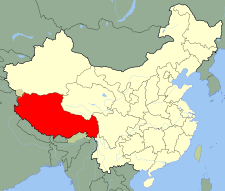LGBT rights in Tibet
| LGBT rights in Tibet | |
|---|---|
 | |
| Same-sex sexual activity legal? |
Legal (China since 1997) Illegal (India) |
| Gender identity/expression | – |
| Family rights | |
| Recognition of relationships | No recognition of same-sex couples |
Lesbian, gay, bisexual and transgender (LGBT) people in Tibet face legal and social difficulties not experienced by non-LGBT persons. The lands comprising the Tibetan Plateau are divided between the sovereignty of the People's Republic of China and the Republic of India. In China, same-sex sexual activity was legalised in 1997, however same-sex sexual activity is criminalised in India (with the prohibition not actively enforced).
LGBT life in Tibet
Unlike its neighbor and cultural sibling Bhutan, Tibet does not have a culture in which open expression of same-sex affection is common.[1]
There are no known Tibetan support groups, and Han Chinese living in Tibet usually use the underground Chinese support groups, which have little to no influence on the Tibetans. (Quotation needed?)
There are reports of a gay bar present in the capital Lhasa called Lanse Tian Kong (or "Blue Sky"), however, the bar is operated in secret, and supposedly, although many of the customers are native Tibetans, it is run by mostly Han.[2] (Closed already)
According to a number of interviews by a reporter from a Singapore-based Asian gay website,[2] Tibetan youth are mostly lax about homosexuality, but Tibetan culture does not allow for public displays of affection. However, as some argue, this is not specific as homophobia, rather, any public display of sexuality is generally frowned upon, partly due to Buddhism's glorification of celibacy.
Ernst Schäfer during his 1938–39 German expedition to Tibet in his account of Tibetan homosexuality he describes the various positions taken by older lamas with younger boys and then goes on to explain how homosexuality played an important role in the higher politics of Tibet. There are pages of careful observation of Himalayan people engaged in a variety of intimate acts.[3]